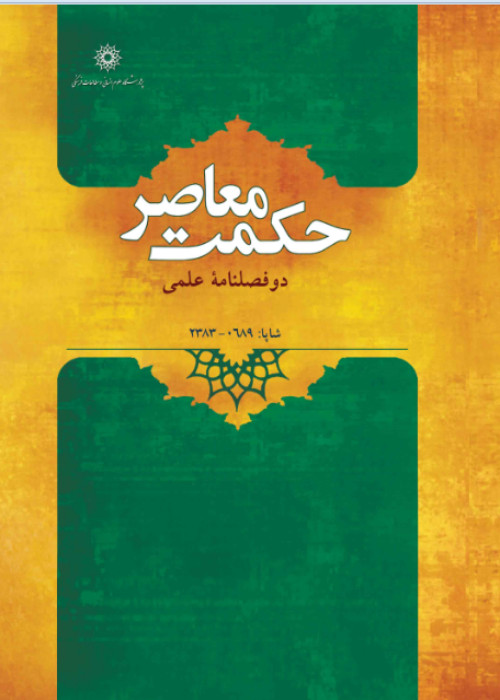Ḥakīm Tonekābonī's Explanation of Ibn Sina's View on Motion in the Categories An Analytical introduction and the Editio Princeps of the Treatise ion the Explanation of Motion in the Categories
Motion in the categories is one of the most significant topics in the natural philosophy of Ibn Sīnā (428 AH/1037 CE). Ḥakīm Muḥammad ibn ʿAbd al-Fattāḥ Tonekābonī (1040 AH/1631 CE-1124 AH/1713 CE), known as Fādhil Sarāb, one of the great thinkers of the Safavid era, composed a work titled Risāla fī Bayān al-Ḥarka fī al-Maqula. In this work, he analyzes and evaluates a topic from the second chapter of the second article of the art of "natural hearing" of Ibn Sīnā's Cure, titled “On the Relation of Motion to the Categories,” where the nature of motion is discussed. Ḥakīm Tonekābonī's explanation is invaluable because his assessment is based on his identification of the nature of motion with the doctrine of gradation. Ḥakīm Tonekābonī's study has a "they say/I say” structure, which encourages the reader to pay attention to the ideas that are rejected as well as those that are accepted in the discussion. Ḥakīm Tonekābonī goes beyond the discussion of the nature of motion and also deals with issues such as the connection between motion and time and instantaneous motion (ḥaraka tawassuṭiyya), as well as continuous motion (ḥaraka qaṭʿiyya). Referring to the views of Abū Naṣr al-Fārābī (339 AH/ 950/1 CE) and Jalāl al-Dīn al-Dawwānī (908 AH/ 1502 CE), he establishes a link between philosophical issues and the commentary tradition of the Tajrīd al-Iʿtiqād. The editio princeps of the treatise, along with an analysis of the text, provides a basis for further discussion of Ibn Sīnā's natural philosophy. Ḥakīm Tonekābonī was born in Sarab, one of the villages of Tonekābon; after acquiring the basics of science with his father, he left for Isfahan and the religious schools of Tonekābon. The date of Hakim Tonekābonī's death is recorded as Monday, the 18th of Dhihjah in 1124 AH, and his burial place is recorded as the Takhte- Fulad of Isfahan. His masters in the intellectual sciences are Mirza Muḥammad Bāqir Sabzevārī (d. 1090 AH), Āghā Ḥossein Khʷānsārī (d. 1098 AH) and Mullā Rajab-ʿAlī Tabrīzī (d. 1080 AH). In this article, Hakim Tonekābonī's view of motion in the categories is examined from a historical and philosophical perspective, based on his work, Risāla fī Bayān al-Ḥarka fī al-Maqula (The Treatise of Motion in Categories). The approach is philosophical, because the issue of motion and its conceptual analysis has a long philosophical ancestry. On the one hand, Heraclitus considered being to be a kind of motion itself, and on the other hand, Parmenides described being as alien to and incompatible with motion. The analysis is at the same time historical, in that the first detailed exploratioin of this issue is found in Aristotle's Physics, whereas in the Islamic world, Ibn Sina in his works, especially in the Shifa (Cure), offered a philosophical explanation of the nature of motion by way of various interpretations of Aristotle's Physics. But Ibn Sina expressed his view of the nature of motion after evaluating previous arguments on the subject and their consequences. Ibn Sina then presents his own interpretation. For example, in other views, according to him, motionis a matter of homonym, or of analogical gradation; Or if it is analogical gradation, it is like settled topoi (places), or fixed blackness or fluid blackness. He himself, however, engages with philosophical analysis of the category of the passion and raises the question of whether passion is motion or a relation between motion and something else. And if passion is identical with motion, then is motion absolute or restricted? With this method, Ibn Sina does not accept the idea of ten categories, like the Aristotelians, and he regards either of the categories as a real genera [this is unclear]. Accordingly, passion is identical with motion. After discussing Ibn Sina's view on the nature of motion, I examine Hakim Tonekābonī's explanation of Ibn Sina's view. The treatise on motion in the categories by Hakim Tonekābonī is considered at two levels: 1. analysis of text itself, 2. further considerations in the form of comments and marginal notes. Hakim Tonekābonī offers further considerations or comments in six sections, which cover only half of the topics of the treatise. Hakim Tonekābonī's answers to the view that the motion is based on analogical gradation are presented in a "they say/I say” structure" that encourages the reader to return to the text of the treatise. Hakim Tonekābonī composed this treatise in order to in response to the debates over Tusi's Tajrīd al-iʿtiqād (The Purification of Belief) and to answer an aporia about the nature of motion.
- حق عضویت دریافتی صرف حمایت از نشریات عضو و نگهداری، تکمیل و توسعه مگیران میشود.
- پرداخت حق اشتراک و دانلود مقالات اجازه بازنشر آن در سایر رسانههای چاپی و دیجیتال را به کاربر نمیدهد.


